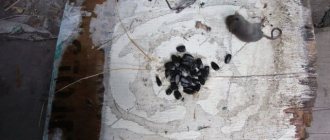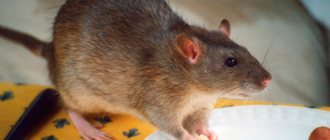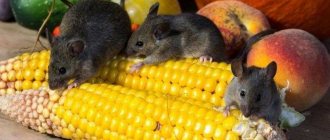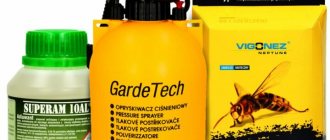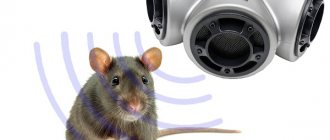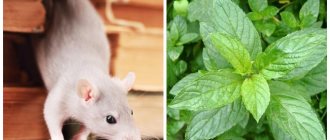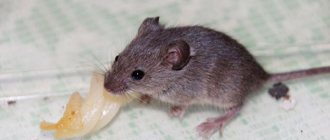How do glue traps work and how effective are they?
The glue trap is a mini-book, which, when opened, will reveal an adhesive composition applied to the “pages of the book.”
The mouse gets stuck in this viscous substance, unable to get out. These devices are absolutely non-toxic and safe for humans and pets.
Let's celebrate! These devices are effective only on mice and young rats, and an adult rat will be able to get out of the “sticky trap.”
Methods for catching mice
For this purpose, a number of devices have been developed that will help to significantly reduce the population of gray pests.
For example:
- Mechanical mousetraps.
- Live traps.
- Containers and cages.
- Electric mousetraps.
The operating principle of the simplest mousetrap:
- The design of a mechanical trap includes a clamping device, a trigger mechanism and a holder. All structural elements are placed on a piece of wooden plank.
- It is best to wear gloves before setting the trap, as mice can smell a person's scent and will reject the bait.
- Before installation, you need to “charge” the mousetrap by placing one of the baits described in the article on the trigger. At the same time, you need to bait the bait so that the mouse has to make an effort to remove the bait from the hook.
- After this, the clamping mechanism is cocked, locked with a holder that is connected to the trigger. In this case, you need to make sure that the mechanism works with the slightest effort.
- In order for everything to work out quickly and correctly, it is better to practice in advance. In this case, you need to make sure that the clamp does not hit your fingers.
- Once the mousetrap is charged and cocked, it can be placed in an area where mice like to appear.
- It works as follows:
- The rodent, sensing the smell of the bait, tries to taste it, which acts on the trigger.
- After this, the holder is triggered and the clamp is released, after which it is triggered and presses the rodent.
- If a larger rodent (rat) reacts to the bait, it can easily take the mousetrap with it.
On a note! To catch mice, use lighter, wooden structures, and to catch rats, it is advisable to take a heavier, metal structure.
Composition and principle of action
The principle of operation of a glue trap for mice and rats is that the glue against rodents needs to be distributed over a small surface of the floor or objects located in places where they accumulate. The animal, running through the sticky trap, will get stuck in the mixture and will not be able to escape from it.
Rat catching glue contains substances such as polybutylene, polyisobutylene and cyclosan. Together they form a viscous mixture that remains sticky for a long time. Thus, not one, but several individuals of mice or rats can fall into a mouse trap at once.
The effectiveness of the glue trap will increase if there is a mouse bait in the middle of the glue coating. This could be a piece of cheese or sausage, bread crumbs, cereal or seeds. Many manufacturers add special aromatic substances to rat glue that attract rodents with their scent. Therefore, it is not necessary to use additional mouse baits.
Types and composition of glue
- In a tube: it must be applied to cardboard, a piece of board or other surface;
- Ready-made trap: available in the form of a plate or box, the bottom of which is covered with glue. To prevent the substance from drying out, the board is hermetically sealed.
Glue in a tube is a cheaper, but less convenient option; it is suitable if you need to make a large number of traps.
Important! Do not apply the product to wooden or porous surfaces as it will be absorbed.
The mouse sticks quickly and forever
- Polybutylene: A plastic polymer that has excellent bonding properties. Its analogue is polyisobutylene;
- Cyclosan: thanks to it, the composition remains elastic for a long time and does not dry out;
- Additional substances: rubber, resins, mineral and vegetable oils.
Using a glue trap is very simple:
- First of all, it is necessary to determine mouse trails and the places where they appear most often;
- Set ready-made or self-made traps along the route of rodents. Some compositions have an attractive smell (this will be written in the instructions) that attracts pests. If the trap does not have such an aroma, you can put a little bait in its center, but in this case the caught mouse will take longer to die, since it will be able to feed itself;
- After a few days you need to come back and see how the trap worked.
If the animal found is alive, it is better to kill it, for example, put it in several bags and tie them, then throw them away. This is a more humane option than waiting several days for the rodent to starve, and the bags will also prevent wild animals from eating the carcass.
Disadvantages of Using Sticky Traps
Like any product, mouse glue is not without its drawbacks in use. Here are the most common:
- Inhumanity. Perhaps this is one of the main negative qualities of this remedy: a slow and cruel death awaits a rodent in a trap. If he is found still alive, then the pest hunter himself will have to suffer, since he will have to think about how to get rid of him. Not everyone is capable of finishing off a helpless little mouse, but throwing it still alive into the garbage chute is no less heartless.
- Allergic activity (hyperallergenicity). There have been cases when substances contained in the glue caused irritation and allergies in people sensitive to them. The sticky trap does not have poison that kills the rat; the rodent dies from exhaustion, which is extremely inhumane
- Extremely difficult to remove glue. Getting glue from sticky traps on children's skin and pet hair is very common. At the same time, it is almost impossible to remove the substance from hair or fur. The only effective way to get rid of matted hairs or hairs is to completely cut off the affected areas. To remove the sticky substance from the skin, you have to use strong chemicals, such as solvent.
- The cry of the victims. Rodents, having fallen into a trap, emit a loud cry for a long time, sometimes a squeal, which is very difficult to hear and sometimes even scary.
The problem of ethics in this case is especially acute. Of course, it is necessary to fight rodents, but if you wish, you can always find a more humane alternative.
How to wash glue off your hands
High efficiency and stickiness can become a big disadvantage if rat catching glue gets on the skin of a person or a pet cat. To remove glue from the skin, you can use vegetable oil. It is necessary to moisten a cloth or cotton pad, apply it to the glue, secure with a bandage and leave for 20-30 minutes. Afterwards, remove the bandage and wash your hands with hot water and soap. If necessary, the procedure can be repeated.
Important! It is not recommended to clean your hands with special glue solvents, as they are too aggressive and can cause irritation.
Rules for using the adhesive composition
Using the substance is not difficult; you can carry out the process yourself. To do this, you must follow the instructions:
- Take a piece of smooth and flat material - cardboard or plastic - no smaller than 10x10 cm for mice and 25x20 for rats. For the latter, it is additionally advisable to attach the selected material to the floor using self-tapping screws, otherwise the animal may drag the entire trap with it and stain the room with an adhesive substance. A cardboard sheet is perfect for applying the adhesive composition.
- When fighting mice, you should lubricate the substrate with glue in strips 1-2 cm wide, maintaining a distance between them of up to 4-5 cm.
- To catch rats, stripes are drawn wider and at a greater distance. The substance acquires irreversible stickiness half an hour after application.
- It is recommended to place bait in the middle of the trap, for example bread soaked in vegetable oil.
Rat traps should be placed in places where victims are more likely to appear - in corners, next to walls and partitions, directly next to burrows, at a distance of 3 to 15 m from each other, based on the volume of the room, its clutter with furniture and the number of pests .
For maximum effectiveness of a glue trap for rats, you need to place it in places where rodents are often found.
At the same time, it is necessary to ensure isolation from children and animals and minimize contamination of the sticky surface; therefore, it is safer to place traps under furniture, inclined towards walls or in special bait houses.
Glue traps must be inspected frequently to see if new animals have been caught and, if this happens, replaced with fresh ones.
If the trap is used for rats, then it is enough to examine it once a day. This is explained by the fact that the caught animal will emit danger signals (squeaking), which is why its fellow tribesmen will avoid this place. But when mice are caught using glue, this factor turns out to be insignificant - these rodents easily run into the trap in a group in a short period of time. Mice are much less cautious animals than their larger relatives; therefore, several victims often fall into one trap at a time.
Basic Rules
Many products are used as bait for mice. But for the bait to work, you should remember a few simple rules:
- It is worth checking the freshness of the products.
- You can't put the same treats. Each trap must contain different types of food.
- You need to change the position of the devices every day and know how to set the mousetrap correctly.
- If the bait does not work, it must be replaced with another one.
The question of which bait is best worries everyone who has encountered rodents in their home. It is necessary to experiment and constantly offer rodents new “dishes”, then the chances of catching pests will increase.
What to do with caught victims
When adhesive users first turn to this method of catching pests, they often have the question of what to do with the caught rodents. The choice of the most appropriate option from an ethical point of view remains up to the hunter himself . There is only one piece of advice that will allow you to deal extremely humanely with a captured animal. To alleviate his suffering, you can generously wet a piece of cloth with gasoline or acetone and place it on top of the caught victim. She will first lose consciousness, and after that, being in an unconscious state, she will suffocate.
To make it easier for a rodent to die in a glue trap, cover it with a piece of cloth soaked in gasoline or acetone.
Few are ready for such actions. Traps are most often simply thrown into the garbage chute with mice still alive, leaving them in a painful and hopeless situation.
There is an opinion that the substance in the trap gradually dries out, but this is not the case. Due to its special composition, it retains its effectiveness until its layer becomes dirty with dust, sand from the street, flour or dirt. For this reason, it is advisable to change the substrate with the substance approximately every 6-7 days.
Advantages and disadvantages
The advantages of glue against mice include:
- Ease of use: the product can be sold separately or as a ready-made trap. In the first case, the mass must be applied to cardboard or a board, in the second - simply installed near your residence;
- Safety: glue for rodents is non-toxic and not dangerous for people and pets, does not emit toxic fumes;
- No odor: the mass does not smell of anything and does not cause irritation;
- Efficiency: if the mouse gets into the mass, it will no longer be able to come off on its own;
- Long exposure time: the substance remains soft for 20 days, does not lose properties in light or heat;
- Low cost: for example, “Clean House” glue against rodents costs about 100-200 rubles.*
However, glue for catching mice also has some disadvantages:
- Still, this is not the most humane way: the mouse dies of thirst and hunger for several days, during which it will call its relatives for help. Of course, you can end her torment by killing her with your own hands, but few people will dare to do this;
- Possible danger for children and pets: upon contact with children's skin, an allergy may occur; if animals stick, you will have to
Types of glue traps against mice and rats
There are a lot of adhesive sticky “traps” on sale and the difference between them is mainly in shape or size. Conducted sociological surveys made it possible to identify the most popular adhesive traps from the total number of adhesive traps on the market.
CatchExpert
- The adhesive plates produced by an Argentine company are shaped like a book and measure 17 by 25 centimeters.
- The adhesive viscous composition applied to the cardboard base has the property of not drying out for a long time, thanks to special additives.
- The glue applied to the surface always has a protective layer and it will need to be removed before placing sticky devices.
Rodentoff
Under the Gryzunoff brand you can find various variations of adhesive devices. They can be in the form of sheets, plastic trays or prefabricated cardboard houses.
There are universal Velcro strips on sale that can catch both mice and rats. But there are also targeted trapping devices - specifically from rats and specifically from mice.
Any version of the Gryzunoff sticky trap has the same technical characteristics.
The adhesive base is created using:
- mineral oil;
- rubber;
- rosin;
- special fragrances - attractants.
Thanks to the fragrances, there is no need to place additional bait on the sticky surface.
Note! Thanks to the components of the adhesive composition, it has the ability not to harden for more than a hundred days, which increases the efficiency of using these devices.
Trap
- The Kapkan glue trap is a universal means for catching rodents.
- The possibility of using these “traps” is quite wide, including places where the use of chemical rodenticides is absolutely not possible.
- The adhesive layer of the trap is made of rubber and plant resin, which attract rodents with their aroma.
- These strips have a fairly thin layer of cardboard under an adhesive backing. This is done so that the installed “trap” does not stand out too much from the surface on which it will be located.
Glue "Clean House"
Glue Clean house from rodents and insects is a popular substance that can be used in different rooms.
The composition is a mixture of three components:
- Polybutylene – 76.6%.
- Cyclocaniol – 10.9%.
- Polyisobutylene – 12.4%.
It has several main advantages:
- Does not freeze for a long time.
- High viscosity, adhesion.
- Does not deteriorate with prolonged exposure to moisture.
- Safe glue for pets and people.
- Low cost.
Efficiency is increased by adding bread, cheese, and cereal to the sticky layer.
Forsyth
An effective trap that differs from other names. Its peculiarity is that it has a specific smell that attracts rodents. During operation, the room temperature cannot be increased above +30 degrees. Used to combat small animals and insects. It does not emit harmful substances, which is why it is used in hospitals, educational institutions, and food storage warehouses.
MR mouse
There is also a name for a special glue that is packaged in tubes. The finished trap is a plate measuring 20x15 cm. It can be effectively used against mice, rats, and insects. It does not contain harmful substances, so the device is considered safe for the human body and pets.
Block
Devices used to catch mice, rats, insects. The record must be removed from the packaging, the protective film removed, and placed in a pre-designated place. The temperature range that the sticky surface can withstand is from +5 to +50 degrees. Using bait you can increase the effectiveness of the trap.
Kotofey
If all previous adhesive devices are disposable, then the Kotofey sticky traps are reusable.
To do this, the kit includes ten adhesive layers, a plywood plate and special clamps for fastening.
The sticky layer is placed on a plywood board using clamps and after a rodent gets on it, it is simply unhooked and disposed of.
The adhesive base is based on:
- polybutylene;
- polyisobutylene.
Good to know! The adhesive composition does not contain any chemical components, which indicates the safety of using this device in human and domestic animal habitats.
Mr. MOUSE
These traps are made in several types:
- in the shape of a house;
- in the form of plates.
Any chosen form is convenient to use - just remove the protective layer and place the trap in places where “gray robbers” are likely to appear.
The adhesive composition does not contain chemical compounds, which allows the plates to be placed in food storage areas.
Best Ultrasound Devices
These models are usually made in China. The bottom line is that they repel rodents. Due to ultrasonic waves, mice are affected. They become uncomfortable being in the range of the device. That is, they independently leave this region. You can buy these priors in many specialized stores.
Important . Such devices have a limited range. It is also necessary to periodically change the batteries if they do not operate on 220 V. Gadgets have a limited range, so to protect a large area from mice you need to buy quite a lot of devices. They are really effective.
PEST REJECT RIDDEX PLUS
This device allows you to get rid of not only mice, but also insects. There is a fairly large operating area here, which is a very important advantage. The useful area is 200 sq. meters. However, items such as curtains, carpets and other furnishings that absorb sound can reduce the usable area by almost half. Manufactured in China. It is safe to use in an apartment. The device does not have a negative effect on cats, dogs or people. You may also be near a pacemaker. This is true for all models operating on ultrasound. However, if you have other rodents at home: hamsters, guinea pigs, it is recommended to abandon this device. The gadget works from the mains. However, the energy consumption is small. There is an indicator that allows you to understand whether the gadget is working normally. The price does not exceed 500 rubles.
Characteristics:
- made in China;
- up to 200 sq. meters;
- work from 220 V.
pros
- can be used at home;
- low price;
- compact gadget;
- there are indicators;
- really effective device;
- works up to 3 years.
Minuses
- depends on the electrical network.
REXANT 71-0007
A very good gadget that is suitable for repelling rodents in the country. It has a large usable area and is very convenient to use. A built-in solar battery allows you not to waste electricity. However, during prolonged bad weather, the device may stop working. The manufacturer has provided a water protection level of IP68. To use, you just need to leave the gadget in the ground. It will get rid of rats, mice, moles and other rodents. Ultrasonic radiation extends to 30 meters. Durable plastic is used in production.
Characteristics:
- for street use;
- there is a solar battery;
- radius 30 meters;
- IP68.
pros
- adequate price;
- easy to find on the market;
- effectiveness has been proven experimentally.
Minuses
- If the weather is bad for a long time, the efficiency decreases.
CLEAN HOUSE
This is a product from a Russian manufacturer, which is considered one of the most popular today. It is used at home and in the garden. With its help, you can forget about the existence of mice and rats for a long time. Operates on voltage 220V. Capable of protecting against rodents over an area of up to 150 square meters. meters. However, with the presence of sound suppression elements, this area is reduced.
Important . In the first days it may seem that there are more mice. But that's not true. The ultrasound causes them to become more active as they begin to experience discomfort. That is, they come out of their holes more often. However, after a few days there will be almost no pests left on the site.
Characteristics:
- made in Russia;
- up to 150 sq. meters;
- works from the mains.
pros
- easy to find in many stores;
- works efficiently;
- large area of action;
- uses energy economically.
Minuses
- depends on the electrical network.
Safety precautions
Despite the fact that mouse glue does not emit toxins or poisons, you should adhere to some safety measures:
- Wear disposable rubber gloves before applying the product.
- Apply glue to the base using a brush or sponge. You can't do this with your hands!
- Remember that glue traps should be kept out of the reach of children and pets. If possible, completely limit entry into the room until the pest is caught.
- After all manipulations, you must wash your hands with soap and running water.
- If glue does get on your skin, you can wash it off with acetone or special gasoline. After finishing work, be sure to wash your hands thoroughly with soap. If the product gets on your hair or fur, it is extremely difficult to wash it off and most often you have to remove the contaminated area with scissors.
Rules of application
Adhesive rat and mouse traps should be installed in the most infested areas. You can simply remove the finished books and houses from the packaging and remove the protective layer from the sticky surface. If parasites are noticed in several places at the same time, then the book can be cut in half, resulting in two traps.
Some manufacturers make products that lure rodents with their scent. But such models do not include adhesive tape for mice. Here, seeds or lard are placed in the middle.
Security measures
Although glue, baited traps, and sticky mouse tapes are non-toxic, care must be taken when using them.
- You should work in rubber gloves and a robe; this will protect your skin and clothing from getting the finished mass on it.
- The substance must be applied with a brush or sponge.
- If there are pets or children in the house, then it is necessary to ensure that the trap is out of reach.
- After handling the product, wash your hands well with soap and water.
If glue gets on the floor, fur, hair or skin is very difficult to remove . Vegetable oil, greasy cream, acetone, kerosene, and gasoline will help remove the drug from your hands. You can remove the mass from walls and floors with acetone and alcohol. If it gets on wood, mechanical cleaning with sandpaper works well.
DIY mouse glue
There is also a recipe for making mouse glue with your own hands. To do this you will need rosin, petroleum jelly, pine resin, and bitumen pitch. But since making glue for mice with your own hands is not so easy, it is easier to purchase a ready-made product in a store. Moreover, the average price of products is in the range of 150-300 rubles. Traps will cost a little more, with the price scale directly proportional to the complexity of the design.
Glue for rodents is effective and safe . But sometimes, even despite the powerful composition of the product, it is not possible to catch the mouse. It is worth trying a different drug or choosing a more humane method of bullying. For granaries it is easier to purchase special poison or mousetraps.
In a house where there are children, it is better to have a cat. If you don’t want to kill rodents, but just need to scare them away, then use ultrasonic devices that emit sounds that can only be heard by animals.
How to remove glue marks
If the adhesive gets on your clothes or carpet, you can use the above-mentioned sunflower oil. However, this product has a serious disadvantage: the oil leaves greasy stains. You can wash them with dishwashing detergent, but this method is not always suitable.
The second option is special solvents, but because of them the material may suffer (the fibers will be destroyed) or fade. It’s worth remembering this when choosing what to wash mouse glue with.
Another option is to use dry cleaning services.
It is not always possible to avoid getting glue from rodents on your hands, floors, wallpaper, curtains, or clothes. Is it possible to get rid of glue stains? How to remove mouse glue from the floor?
Mouse catching glue can be wiped off most hard surfaces with alcohol solvents or acetone-based compounds. Hardened glue can be removed from a wooden floor, most often only mechanically using fine sandpaper.
A much bigger problem is removing such glue from fabrics (sofa upholstery, clothes, curtains). Solvents tend to damage fabric.
Therefore, unfortunately, only dry cleaning can advise on how to remove mouse glue from clothes. The arsenal of home remedies includes a soap solution and careful scrubbing of the glue.
You can also remove fresh glue that gets on your hands using a solvent containing alcohol or acetone (nail polish remover or window cleaning liquid). Fresh glue is removed with sunflower oil and rich hand cream.
As evidenced by reviews of glue for mice, the product helps to completely and quickly get rid of mice and rats in the house, protect yourself and your family from these prolific rodents, which cause great trouble and pose a threat to the health of loved ones. Of course, this method cannot be called humane, but compared to the use of mechanical mousetraps, it is more gentle.
Where to buy glue for mice? This can be done in the hardware department of any supermarket.
You can make glue for mice with your own hands by mixing bitumen pitch with Vaseline, rosin and pine resin.
How to replace mouse glue
In some situations, the use of glue is impossible or ineffective. In this case, there are several alternative options:
- You can use a traditional mousetrap. The rodent will be killed without your assistance. All you have to do is throw it away.
- Mummifying poison. Quite a convenient way to fight rats. But then the dead rat or mouse will lie under the furniture, where you will not be able to see or reach it.
- Loose poison. This type of poison is suitable only in rooms where there are no other inhabitants. The bright color of the drug can attract a child or pet. In addition, a cat or dog can eat a poisoned rodent.
- Ratcatcher cat. A rather unusual method of controlling rodents, but very effective.
- Ultrasonic repeller. The most modern method. It is based on the fact that a device inserted into a socket emits a sound that cannot be heard by humans, but cannot be tolerated by mice and rats. They just run away.
Brands of adhesives against mice
Today, several manufacturing countries produce glue for catching mice. Here are the most common brands:
- Alt glue (Alt) made in Russia. This mechanical rodent control device can be used in all types of premises, as well as in garden areas. Alt glue achieves its greatest effectiveness in the fight against house mice. Rats are the most cautious, so it makes sense to deal with them in several ways.
- Kotofey is a Russian glue trap. This glue is suitable not only for catching mice and rats, but also for crawling insects such as snails and caterpillars.
- Forssyth (manufactured in Russia). This glue is good because it is a drug of the fourth class of danger, which means it can be used in rooms with children and people prone to allergies.
There are also imported products. Here are the most popular ones:
- RaTrap - Czech Republic. This glue is highly sticky, which allows it to hold even large pests. It also contains a food attractant that lures rodents.
- EuroGuard is an Italian product. It differs from other drugs in that it can be used in a wide range of temperatures, which is especially important when catching rodents in basements and refrigerators.
All of the above products are packaged identically (in an aluminum tube of 135 grams each) and have a similar chemical composition and effect. To choose a specific brand of glue for catching mice, you will have to try several products from different manufacturers.
Ready-made glue boards are also available on the market. The convenience of using them is that you do not need to look for suitable cardboard and apply the glue yourself. Accordingly, in this form the drug will cost much more.
Alternative to glue and cool traps
There are a number of alternative options that can replace anti-mouse glue. They have their own characteristics, which leads to changes in operating rules.
These include:
- Classic mousetraps. The death of a rodent occurs almost instantly. It is important to choose the right bait, choose a place to install the device and not leave your own odors. Rodents can successfully bypass them due to non-compliance with clear installation rules.
- Poison. It can only be used in rooms where there are no people or pets. Prohibited for use in hospitals and food storage warehouses. Poisoned mice and rats come out of hiding. But some of them die in hard-to-reach places, decomposing in the process. On sale you can find a poison that mummifies the carcasses of animals, thereby eliminating the persistent, unpleasant odor.
- Ultrasonic repeller. It is a compact device that connects to a common network. Creates ultrasonic waves that are inaudible to humans. Rodents are frightened by this sound. They begin to avoid the room where the device is operating. However, over time, mice can become accustomed to ultrasound. As a rule, rats are repelled by signals with a frequency of 20-50 kHz, mice by 10-20 kHz.
Many owners of private houses or apartments get a cat. This pet will not only create a more comfortable environment and delight others, but will also prevent mice from appearing. But in this case, the feline family is likely to catch some kind of infection or even get poisoned through a poisoned rodent carcass, which happens to almost all animals.
What to choose: glue or ready-made traps?
First you need to understand the question, how does mouse glue work? The whole secret lies in a specially developed substance that does not dry out over time and has such strong properties that the mouse sticks to it in an instant. The animal rests with its other paw, but it also sticks tightly. Often the rat sticks with its entire body and is completely immobilized.
There are two forms of the product: glue and ready-made traps. The first option looks like a tube with a product that needs to be applied to cardboard, a board or other surface. The trap looks like a ready-to-use plate with glue already applied at the factory, which is covered with a protective film on top. The first option is cheaper, but it makes sense to purchase it only when producing a large number of devices.
The rodent dies not from the very fact of sticking, but more often from hunger and thirst. This will take several days. So if a person finds an animal stuck to a mouse trap, the mouse will need to be killed, thrown into the trash, or disposed of in some way. Remember that a corpse smells extremely unpleasant, so you need to throw it away while it’s still alive. Actually, these are all the rules regarding how to use mouse glue.
Features of glue for rodents
The drug does not have a strong odor, there are no toxic substances in its composition, so it is completely harmless to people and comfortable to use. The adhesive may contain active ingredients: cycloisan, as well as polyisobutylene or polybutylene.
The penetration of these substances into the body in minimal quantities will not lead to poisoning. However, for preventive purposes in these circumstances, it is recommended to perform gastric lavage and seek specialized help from a doctor.
The procedure for using mouse glue directly depends on the form of its release. And it is produced in two versions:
- The finished trap is a cardboard base on which a layer of adhesive has already been applied. It is easy to use, you just need to remove it from the packaging and place it where necessary. The cardboard trap is impregnated with a special substance whose aroma is attractive to mice. The animals themselves come running to this smell and stick to the cardboard;
- the liquid suspension is packaged in hermetically sealed bottles or tubes. This product can be applied to various washable substrates (glass, ceramics, plastic, etc.). It is recommended that you first test in a small area how the suspension will wash off the surface. And if you have no intention of experimenting, you can apply mouse glue to a piece of cardboard or plywood, which you can throw away after use.
Before using glue against rodents, you should read the manufacturer's instructions, since each drug has its own characteristics and requires certain conditions for its use.
Disadvantages of the method
The effectiveness of the products is noticeably reduced in rooms with high concentrations of dust, dirt and moisture. Therefore, to achieve maximum effect in such conditions, it is recommended to change the substrate with glue for rats at least once a week.
When using adhesives, the following factors must be considered:
Pets may be tempted by the bait and harmed by the drugs. This is especially true for hamsters, guinea pigs and cats. In such cases, in order to remove the stuck composition, you will have to cut out the glue along with the wool. Allergic rashes may appear on the skin of animals. It is highly undesirable to use the compositions in rooms where there are children.
If you are careless, they can get dirty; the glue will have to be removed with special means. This method is ineffective in fighting rats and is more suitable for catching mice. And the last thing is getting rid of trapped animals
